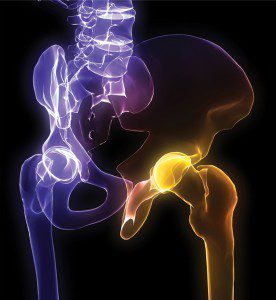By John C. Kagan, M.D. –


Hip pain after a few tennis volleys or golf swings can vary in form and intensity. Overuse of the hip joint due to twisting and muscle strains from sudden forced muscle contractions around the hip are common. Symptoms may include discomfort or stiffness in the groin, buttock or thigh area. For mild to moderate overuse injuries, the RICE method is typically recommended:
• Rest: Take a break from the activity that caused the pain. Consult with your orthopedist for recommendations on the use of assistive devices if needed.
• Ice: Use cold packs for 15-20 minutes at a time, several times a day. To avoid damaging the skin, do not apply ice pack directly to the skin.
• Compression: To prevent additional swelling, wear an elastic compression bandage.
• Elevation: To reduce swelling or inflammation, recline and put your leg up higher than your heart while resting.
Minor hip pain can be prevented through proper warming up and stretching activities. Athletes who do warm ups are less likely to incur injury compared to those who do not.
• Warm up and stretch: Jumping jacks, walking or jumping in place are just a few warm ups that can be done. Taking 3 to 5 minutes of time to warm up the areas that are most prone to injury, like the hips, can make a dramatic difference in the muscles. Following the warm up, athletes should practice slow and gentle stretches for 30 seconds on each side and for each muscle area
Since many injuries are multifaceted, it is critical to visit an orthopedic surgeon to rule out any potential underlying disease. At times, pain in the hip area can be an indication of disease such as osteoarthritis, rheumatoid arthritis, avascular necrosis or bone cancer. Pain, stiffness, swelling and loss of function can result in a person’s inability to engage in activities altogether, so seek treatment if the pain is unmanageable and extends well beyond the tennis court or golf course.
For those dealing with hip pain that limits everyday activities, today’s treatments for chronic hip pain include both non-surgical and surgical treatment options. Your orthopedic surgeon will review your medical history, perform a thorough evaluation and conduct necessary tests such as X-rays or scans. In general, medications such as analgesics, narcotics and steroid injections may be the first course of treatment, depending on your condition. In addition, water therapy, exercise and physical therapy may be recommended.
When non-surgical options fail to relieve pain and symptoms, surgery may be recommended. More than 260,000 hip replacement surgeries are performed in the U.S. each year to help relieve pain and restore mobility. Hip replacements are performed successfully for people of all ages. Recommendations for surgery are based on the patient’s pain and disability level, not age. The surgery involves removing the head of the thighbone (femur) and replacing the ball-and-socket part of the hip with artificial implants. The ball component of the implant is typically made from a metal or ceramic material and the socket component is made of a durable form of plastic, ceramic or metal. Benefits of hip replacement include less pain, greater mobility and better alignment.
While recovery from hip replacement differs for everyone, post-surgery medication, physical therapy and instructions will be prescribed by your surgeon, as well as appropriate follow-up visits to aid in recovery.
 Southwest Florida's Health and Wellness Magazine Health and Wellness Articles
Southwest Florida's Health and Wellness Magazine Health and Wellness Articles

